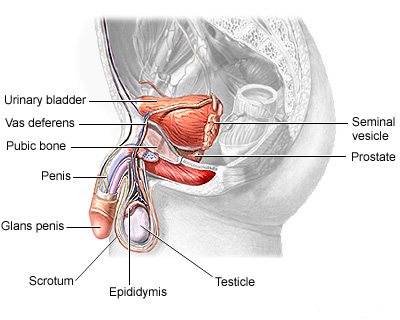Varicocele
Contents
When to Contact a Medical Professional
A varicocele is the swelling of the veins inside the scrotum. These veins are found along the cord that holds up a man's testicles (spermatic cord).

The male reproductive structures include the penis, the scrotum, the seminal vesicles and the prostate.
Causes
A varicocele forms when valves inside the veins that run along the spermatic cord prevent blood from flowing properly. Blood to backups leading to swelling and widening of the veins. (This is similar to varicose veins in the legs.)
Varicoceles develop slowly most of the time. They are more common in men ages 15 - 25 and are most often seen on the left side of the scrotum.
A varicocele in an older man that appears suddenly may be caused by a kidney tumor, which can block blood flow to a vein. The problem is more common on the left side than the right.
Symptoms
· Enlarged, twisted veins in the scrotum
· Painless testicle lump, scrotal swelling, or bulge in the scrotum
· You may not have any symptoms
Exams and Tests
You will have an exam of your groin area, including the scrotum and testicles. The health care provider may feel a twisted growth along the spermatic cord.
Sometimes the growth may not be able to be seen or felt, especially when you are lying down.
The testicle on the side of the varicocele may be smaller than the one on the other side.
Treatment
A jock strap or snug underwear may help ease discomfort. You may need other treatment if the pain does not go away or you develop other symptoms.
Surgery to correct a varicocele is called varicocelectomy. For this procedure:
· You will receive some type of numbing medication (anesthesia).
· The urologist will make a cut, usually in the lower abdomen, and tie off the abnormal veins. This directs blood flow in the area to the normal veins.
· You will be able to leave the hospital same day as your surgery
· You will need to keep an ice pack on the area for the first 24 hours after surgery to reduce swelling.
An alternative to surgery is varicocele embolization. For this procedure:
· A small hollow tube called a catheter (tube) is placed into a vein in your groin or neck area.
· The health care provider moves the tube into the varicocele using x-rays as a guide.
· A tiny coil passes through the tube into the varicocele. The coil blocks blood flow to the bad vein and sends it to normal veins.
· You will need to keep an ice pack on the area to reduce swelling and wear a scrotal support for a little while.
This method is also done without an overnight hospital stay. It uses a much smaller cut than surgery, so you will heal faster.
Outlook (Prognosis)
A varicocele is often harmless and often does not need to be treated.
If you have surgery, your sperm count will likely increase. However, it will not improve your fertility. In most cases, testicular wasting (atrophy) does not improve unless surgery is done early in adolescence.
Possible Complications
Infertility is a complication of varicocele.
Complications from treatment may include:
· Atrophic testis
· Blood clot formation
· Infection
· Injury to the scrotum or nearby blood vessel
When to Contact a Medical Professional
Call your health care provider if you discover a testicle lump or need to treat a diagnosed varicocele.
Alternative Names
Varicose veins – scrotum
Source: http://www.nlm.nih.gov/medlineplus/ency/article/001284.htm

